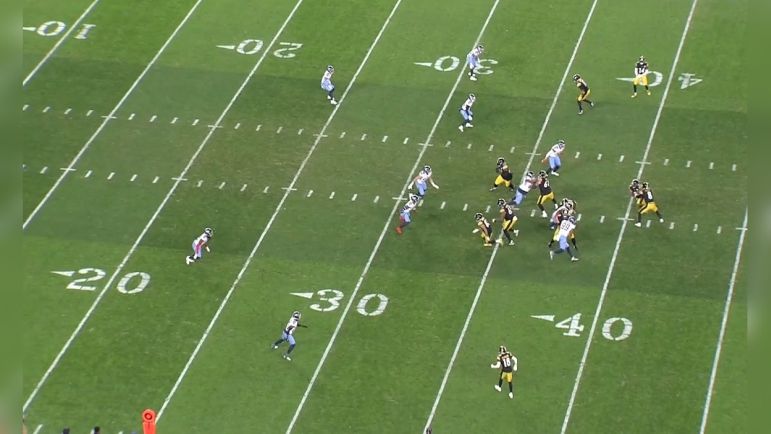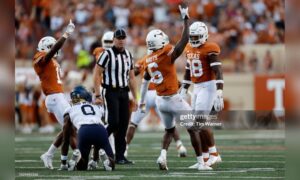Quick film room today that can be seen as an extension of our article yesterday outlining the quality playcalls and gameplan from OC Matt Canada in the Pittsburgh Steelers’ 20-16 win over the Tennessee Titans. Pittsburgh used more RPOs in this game than they had all season and QB Kenny Pickett was willing to throw the ball more than he had.
Today, we’ll break down a couple of those RPOs and what made them effective. A reminder that an RPO is a run-pass-option that gives run and pass possibilities. The quarterback decides to hand the ball off or throw based on leverage, box count, and safety shell.
RPOs (Run Plays)
Split zone RPO here. To the top, the receivers are stacked to help create off-coverage, and the passing component of the play is paired with the split zone run game. In 11 personnel, the Steelers are even in box count, six blockers against six defenders. Tennessee is also in a two-high shell.
With those two factors, even box count and the two-high look, it tells Pickett to hand the ball off to RB Najee Harris. It goes for a solid run of about ten yards. Credit to RT Broderick Jones and TE Connor Heyward for adjusting assignments on the fly and for Harris following behind before showing power to fall forward and finish the run.
Same concept here. And the same rules apply. Stacked receivers at the top as the passing component. The only difference is this is a gap/power run with pullers. Six-man box count, two high-shell, that’s a situation where you want to hand the ball off and trust your guys to execute.
RB Jaylen Warren hits the hole with authority and it turns into a big gain to get the Steelers into the red zone. Good decision by Pickett and nice execution up front by the line and back.
I also like the wrinkle here of leaving the backside EDGE player (the LDE) unblocked as you’d get on a read option. That reduces the number of players the offense needs to block (now they have six blockers to account for five defenders) and allows RT Broderick Jones to climb to the linebacker. And if the EMOL really crashes down hard against the run, Pickett can throw the ball.
One more example in the run game. Different pass component with WR Calvin Austin III orbiting around before swinging out into the flat. But again, it’s a six-man box and even box counts against a two-high safety shell. One you should be able to run out of and the Steelers do, Harris with a solid run to get out of the shadow of their end zone.
RPO (Pass Plays)
Just one we’ll highlight to show you what a pass out of this looks like and the picture that changes for the quarterback. Gap/power run component if Pickett wants to hand the ball off to Harris. It is a two-high shell with a six-man box.
But Pickett sees the NCB to the bottom blitzing off the edge. With a stack to the bottom and the rest of the secondary playing off, Pickett hits Johnson on the smoke screen. WR Allen Robinson throws a block out in front, leaving Johnson one-on-one with the safety. He ends up making the tackle but Johnson picks up the first down on 2nd and 2. Gets seven yards and moves the sticks. I’ll take it.
As an offense, you should always have answers. Whatever a defense brings, you have a counter. If not, that’s when offenses begin to struggle and that’s when coordinators aren’t serving their unit well.
RPOs come with their issues. Pittsburgh got flagged for ineligible man downfield because of a busted play (WRs never looked for the ball) on the first drive and there were a couple of questionable decision/design things here, but I want to see more of this going forward. Trust Pickett to make the right read. Give your offense multiple ways to win on a play. Overall, the results were positive.








